Delinquent behaviour is rarely tolerated, much less rewarded. When a puppy performs backyard excavation works, it doesn’t get a Schmacko. Should a bully throttle a nerd, school captaincy is unlikely. And if a work colleague supports Donald Trump then gets showered in a burning long black, you’d probably say, fair enough. But it won’t win you that promotion.
Cars are the exception. We tag cars as ‘widow makers’ then elevate them to legendary status (step forward 911 GT2 and F40) and overpowered local muscle cars that were rowed mercilessly around Bathurst decades ago still fetch big bucks (wouldn’t you rather a nice, new SS V Redline?).
The Peugeot 205 GTI is renowned for its devilish oversteer. Meaning, if you don’t get steering and throttle inputs exactly right in a corner, it will pitchfork you. Then bury you in the backyard. Then poor hot coffee on your grave. Naturally, this model is celebrated as a seminal hot hatch and all-time great.

Enter the 208 GTi 30th Anniversary and the closest thing to a retraction you’ll get from a baguette eater. There is nowhere to hide when a model directly references a revered ancestor released in 1984.
This $35,990 limited edition rides 10mm lower compared to a standard 208 GTi, the springs and dampers are firmer, tracks wider (by 22mm front and 16mm rear) and the steering is quicker. the 1.6-litre turbo four’s increased outputs – now up to 153kW/300Nm – are channeled through a mechanical limited-slip diff to stickier 18-inch tyres, and the 1160kg three-door scoots to 100km/h in 6.5 seconds.
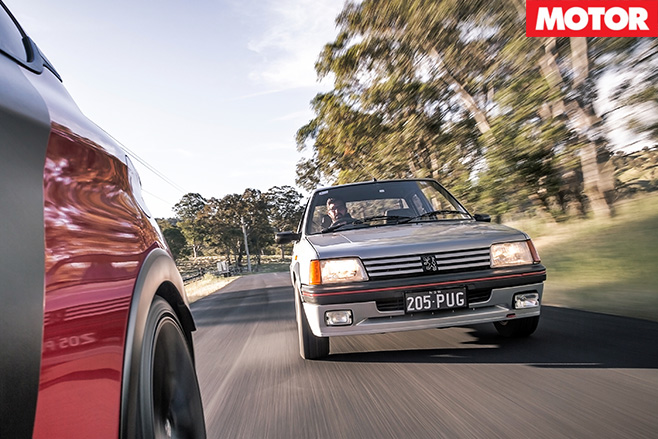
It is just 3.7 metres long, 1.59m wide and 1.36m tall. The current pudgy Pug pushes those measurements out by 27cm, 15cm and 9cm, respectively, the difference today between a micro- and a light-hatch.
But no crummy micro hatch can match the design of the pretty 205 which still stands up three decades later. The French can do style and the GTI additions of oblong driving lights, licks of red paint across the bumpers, side cladding and tow hook, and 1.9 and GTI badging on the rear three-quarter panel are delicious fondant icing.
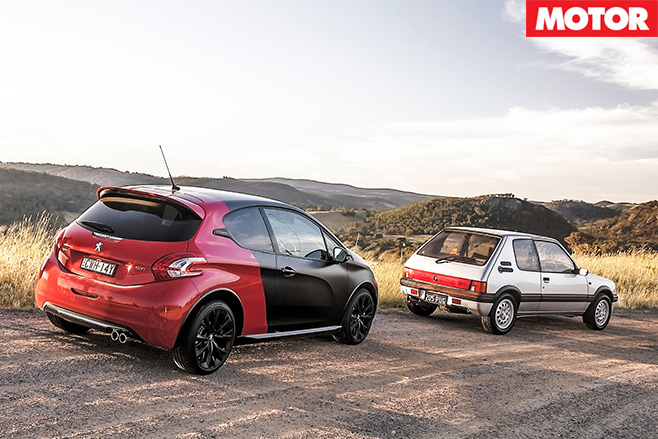
By contrast, the 208 GTi 30th Anniversary’s front track measures 1498mm to the rear’s 1494mm. It isn’t subtle, either, particularly in ($4000 optional!) ‘coupe franche’ (clean cut) paintwork that references the line between matte black and solid red.
The 30th also gets red floor mats as a nod to the full red carpet standard on the 205 GTI, though all its modern trinkets mean it can’t hope to match the simplicity of the older Pug’s grey dash.

My 205 GTI is not concours. It has been well maintained but some cracks have appeared on a body with the torsional rigidity of a tuna can. However, the driver’s seat is plush and snug, the driving position astoundingly good, especially for a car with a fixed wheel and without seat height adjustment.
Debate still rages overseas whether the 1.6- or 1.9-litre is the one to have in a 205 GTI, even though Australia only received only the latter, initially with a detuned (blame the catalytic converter) 75kW at 6000rpm and 142Nm at 3000rpm.
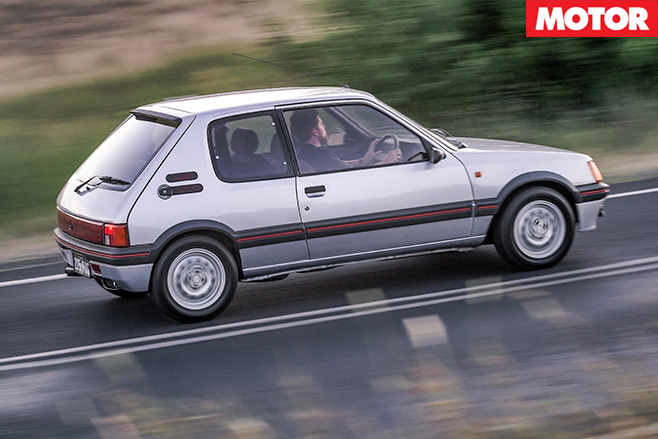
Right foot buried, the 1.9 has an angry, thrashy bark backed by pops and bangs from the (guilty pleasure) aftermarket exhaust. Throttle response is hard-wired and the manual ’box is of the long-throw but perfectly-tight and smoothly-oiled variety.
The non power-assisted steering is a slow-twirling pain around town, but into corners at speed it delivers amazingly crisp and immediate response, yet is never nervous. The little Pug loves hard braking before a corner too, maximising weight over the nose and permitting that wide front track to deliver road-clawing agility to rival contemporary hot hatches.
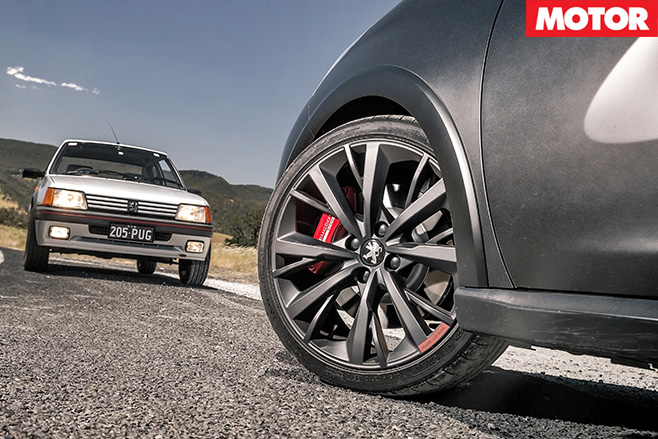
And now with more grip, the passive rear steer that follows the 205 GTI everywhere can be carefully managed, with nuanced throttle lifts translating to minute attitude adjustments. Others following are bemused at the way the tail falls slightly out of step, the front-end being the rock solid flagpole to the wavy cloth behind it.
The new Peugeot is so much faster. Corners approached in the top of second in the 205 GTI run deep into third in the newer car. The sheer sensation of speed in the 208 GTi 30th Anniversary quickly rips the rose-tint off 80s glasses and the Rocky Horror Picture Show album from the cassette deck. Its grippy Michelin Pilot Super Sport rubber can be smeared across corners with all the subtlety of applying Vegemite to toast with a machete. Then the LSD helps deliver full power to them.
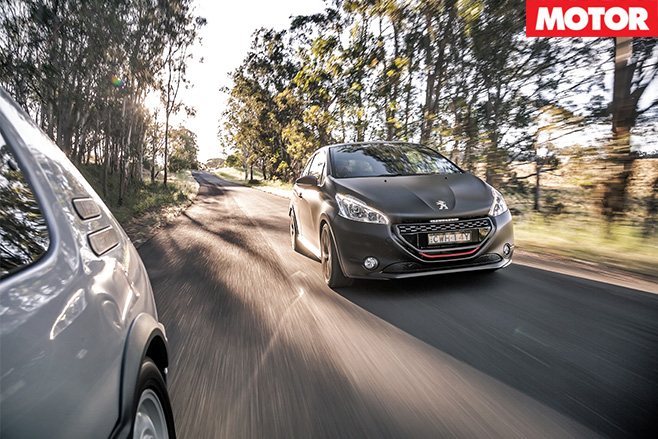
Sure, its 1.6-litre turbo is effective, but it doesn’t rev as sweetly or cleanly as the same overhauled 201kW/330Nm unit in the 308 GTi we tested the following week. And its manual gearbox hasn’t got the lovely, direct throw of the 205 or its rivals. It isn’t until we barrel down the other side of a bumpy hillcimb that the 30th reveals a split personality to match its split colours. I didn’t expect to exit a 90-degree right-hander then flick into a 90-degree left-hander and require an armful of opposite lock.
The 208 may not have the front-to-rear track mismatch of the 205, but it seems that by making the front-end stiff and darty, the rear-end of this short-wheelbase hatch has become more skittish and playful, in a great but challenging way.
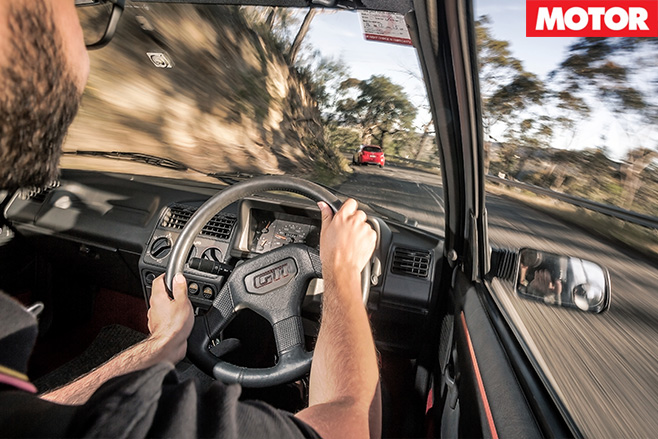
After a hard 500km, the 205 GTI idles perfectly at 800rpm and, despite whiffs of blue spoke that indicate, let’s say, plentiful top-end lubrication, the engine keeps on giving. It’s only been taken out for fast drives over the last 20,000km, a timely reminder that Peugeot was once known for reliability.
So my 30-year-old GTI isn’t a delinquent child after all. It’s supremely chatty, connected if not always perfectly controlled, and able to play both torquey, roomy inner city runabout and agile hot hatchback.

Unique in abilities, yet with similar breadth and contrast, this 208 delivers its many talents on different roads to please many different drivers, just as my trusty 205 did thirty years ago. It may even be silly enough to be as memorable as a 205 GTI.
| u00a0 | PEUGEOT 205 GTI | PEUGEOT 208 GTI 30TH |
| Body | 3-door, 5-seat hatch | 3-door, 5-seat hatch |
| Drive | front-wheel | front-wheel |
| Engine | 1905cc inline-4, SOHC, 8v | 1598cc inline-4, DOHC, 16v, turbo |
| Bore/stroke | 83.0 x 88.0mm | 82.0 x 92.0mm |
| Compression | 8.4:1 | 8.6:1 |
| Power | 75kW @ 6000rpm | 153kW @ 5800rpm |
| Torque | 142Nm @ 3000rpm | 300Nm @ 1700rpm |
| Power/weight | 80kW/tonne | 129kW/tonne |
| Transmission | 5-speed manual | 6-speed manual |
| Weight | 940kg | 1185kg |
| Suspension(F) | struts, coil springs, dampers, anti-roll bar | struts, coil springs, anti-roll bar |
| Suspension(R) | torsion beam, coil springs, anti-roll bar | torsion beam coil springs, anti-roll bar |
| L/W/H | 3705/1589/1355mm | 3962/1740/1415mm |
| Wheelbase | 2420mm | 2538mm |
| Tracks | 1393/1328mm (f/r) | 1498/1494mm (f/r) |
| Steering | unassisted rack-and-pinion | electrically-assisted rack-and-pinion |
| Brakes(F) | 247mm ventilated discs | 302mm ventilated discs, 4-piston calipers |
| Brakes(R) | drums | 249mm solid discs, single-piston calipers |
| Wheels | 14.0 x 5.5-inch (f/r) | 18.0 x 7.5-inch (f/r) |
| Tyre Sizes | 185/60 R14 (f/r) | 205/40 R18 86Y XL (f/r)u00a0 |
| Tyre | Bridegstone Potenza | Michelin Pilot Super Sport |
| Price as tested | $29,500 (new) | $35,990 |
| Pros | Brilliant steering; gearshift; engine tractability, handling | Diff works wonders; strong brakes; masses of grip |
| Cons | Flimsy build, lacks straight-line grunt; on-limit handling | Can be a handful; gearshift lacks precision |
| Star Rating | 4.5/5 | 4/5 |
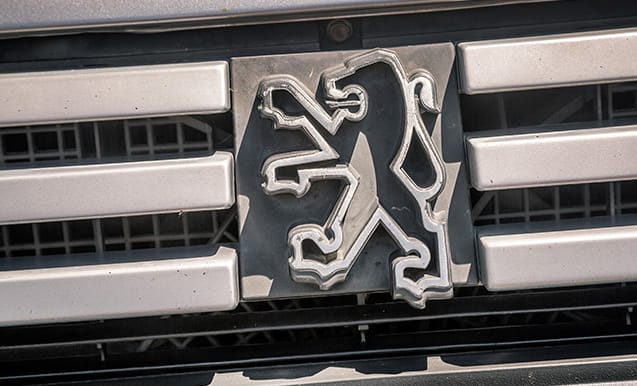
Fast bum-draggers
Hatches that wrote the Gallic glory story
IN 1976, the 68kW Renault 5 duelled with the VW Golf GTI to be the first official hot hatch. In 1987, the Series I 205 GTI lobbed here, followed in 1989 by the Series II (distinguished by new dashboard and red rear applique) and then the $37,500 Series III (15s, clear indicators, 83kW/153Nm upgrade) in 1992. Only Series III Pugs got air-con and power steering, earlier cars made do with just air-con, as both wasn’t possible on right-hand drive cars. The 1994 306 S16 was brilliant but unreliable and had a 111kW/190Nm twin-cam, 16-valve 2.0-litre version of the 205 four (an engine conversion is on my to-do list if ever my 205 engine goes bust). The 124kW/196Nm 306 GTi-6 was the last genuinely great Peugeot, but production ended in 2000. A year later, French car fanatics quickly found a replacement in the superb Renault Sport Clio 172 then 182. In 2007, Renault released the Renault Sport Megane F1 Team R26 and introduced us to front-drive turbo torque with LSD, and its current Megane 275 Trophy-R is the most capable front-drive hot hatch ever. Peugeot Sport is on a winning streak, though, with the 208 GTi 30th Anniversary and now the 308 GTi which has 201kW and an LSD.





